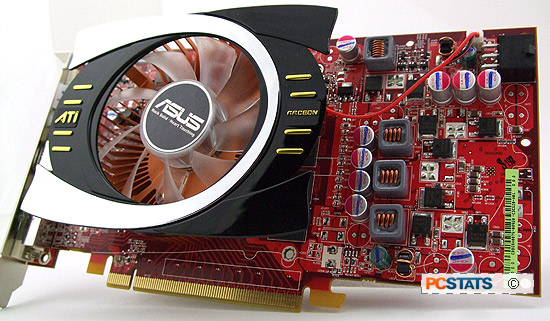 |
| Overclocking Results: |
|
|
The ASUS
EAH4770 HTDI/512MD5/A videocard ships with its ATI 'RV740' GPU running at 750MHz
and 512MB of GDDR5 memory clocked at a respectable 800MHz, or effective 3.2GHz
(quad-pumped).
As always,
PCSTATS overclocked the videocard through ATI's Catalyst Control Center using
ATI Overdrive. The fan was set to run at 100% from the start and PCSTATS started
with the GPU first, pausing to test the results with a quick 3D benchmark before
continuing. We take note of any stability problems or artifacts, then list the
maximum stable and artifact-free overclocked speed the videocard achieves. The
same process is repeated with the memory, then both GPU and memory are
overclocked together.
ASUS' EAH4770 is a mainstream videocard, which generally
means good overclocking is to come. Unfortunately the overclocking sliders in
ATI Catalyst Control Center don't have all that much range... in fact the GPU
could be overclocked to a maximum of just 830MHz. Considering this, we didn't
bother increasing the clock speed in small jumps, and instead went right for
gold. The Radeon HD 4770 was pushed from its default of 750MHz right to 830MHz
in one fell swoop. The graphics card handled this without breaking a sweat - no
visible artifacts or instability.
 The memory options were similarly
limited by ATI Overdrive, so with the GPU back at stock speeds the 512MB of
GDDR5 memory on the ASUS EAH4770 was aggressively overclocked right to the max -
850MHz.
The memory options were similarly
limited by ATI Overdrive, so with the GPU back at stock speeds the 512MB of
GDDR5 memory on the ASUS EAH4770 was aggressively overclocked right to the max -
850MHz.
As you might
have already guessed, without any effort PCSTATS was able to overclock ASUS'
EAH4770 videocard to 830MHz GPU / 850MHz
memory. A nice videocard overclock sure, but I couldn't help thinking
that the Radeon HD 4770 has a lot more headroom to spare...
Prelude to Benchmarks
The details of how the ASUS EAH4770 HTDI/512MD5/A
videocard was configured for benchmarking; the specific hardware, software
drivers, operating system and benchmark versions are indicated below. All
benchmarks for the videocard were run in Windows Vista Ultimate, the reference
video cards were tested in both Windows XP and Vista for the DX10 benchmarks.
PCSTATS is in the process of making the transition to a
Windows Vista and Intel CPU test platform, so keep this in mind as you scan the
benchmark results. In the second column are the general specs for the reference
cards this Radeon HD 4770 videocard is compared against.
 |
| PCSTATS Test System Configurations |
|
|
Benchmark results are organized by GPU manufacturer first
(AMD/ATI or nVidia), then by GPU generation, and then by GPU class (high end,
mainstream, value). This approach provides a clearer view of how performance can
differ from generation to generation, and class to previous generation. The
product being tested is marked with the red colour bar.
